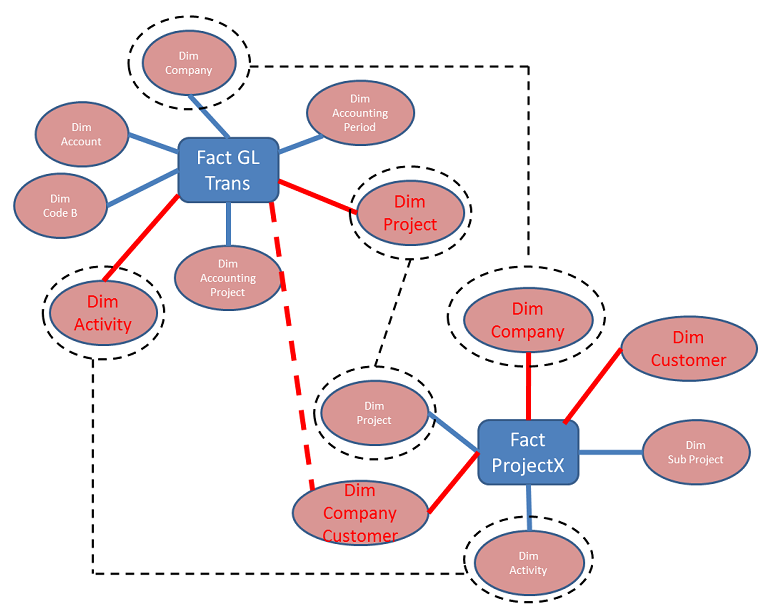Cross Product Reporting¶
This page presents some information related to Cross Product Reporting.
General¶
With cross product reporting we mean reporting where Information Sources from different product areas are combined in one and the same report. To make this possible, the general solution is to make sure the Information Sources to be used share the same dimensions. Look at the dimensions as the glue between Information Sources.

Always do the outmost to add as many common dimensions as possible when developing Information Sources, since this can be seen as a future investment, simplifying cross product reporting.
Examples of Common Dimensions¶
The following dimensions in IFS Cloud are some of the common ones, typically suitable for Cross Product Reporting.
- DIM_COMPANY
- DIM_CUSTOMER
- DIM_SUPPLIER
- DIM_PROJECT
- DIM_ACTIVITY
- DIM_CURRENCY_CODE
- DIM_SITE
- DIM_BI_TIME (and inherited time dimensions)
- DIM_RPD_COMPANY_PERIOD
Example¶
Looking at the following example:

We have one Information Source based on Project information and one based on General Ledger Balances in Financials. Combining these two Information Sources is not possible since they do not share any dimensions. By adding two dimensions we can start combining them.

The two Information Sources now share the dimensions DIM_COMPANY and DIM_PROJECT.
Another example is the following:

Common dimensions in this example are DIM_COMPANY, DIM_PROJECT and DIM_ACTIVITY.
The dimension DIM_COMPANY_CUSTOMER is a possible dimension that can be directly connected to FACT_PROJECT_X, since this Information Source contains both company and customer. It is more difficult to connect this dimension to FACT_GL_TRANS since customer as part of a company is not defined in this Information Source.
If however we know that in one specific company, one given code part contains the customer identity, it is possible to connect the DIM_COMPANY_CUSTOMER dimension using columns COMPANY and CODE_<x> for On Line access and the DIM_CODE_<x>_ID column for Data Mart access. The limitation will be that this connection only applies for one or more companies that use one and the same code part to represent the customer identities.
A Common Period Concept¶
To support Cross Product reporting with respect to a common period definition, a period concept named Reporting Periods. The basic data is available in Accounting Rules.
There can be different definitions of Reporting Periods called Reporting Period Definitions. A Reporting Period Definition consists of one or many reporting years with a set or reporting periods. Each reporting period defines a given date interval.
One or many companies can be connected to a Reporting Period Definition. The Accounting Period Calendar definition for each company can be mapped to the existing Reporting Periods in a given Reporting Period Definition.
The main idea is to enable cross product reporting where information from an Information Source in Financials is combined with one or more non-Financial Information Sources, where the report data is grouped/presented with respect to a common date grouping, i.e. the Reporting Periods. To combine two Information Sources it is necessary that one or more dimensions are shared. The Reporting Periods solution defines two dimensions:
- DIM_RPD_PERIOD
- To be used when there is no Company available or when it is required to map a date, regardless of company. It means mapping dates to reporting periods.
- For more information follow this link.
- DIM_RPD_COMPANY_PERIOD
- To be used when there is a company available.
- The dimension provides the possibility to connect either to a typical Financial Information Source, using company, accounting year, accounting period and date, or to a non-Financial Information Source using company and date.
- For more information follow this link.